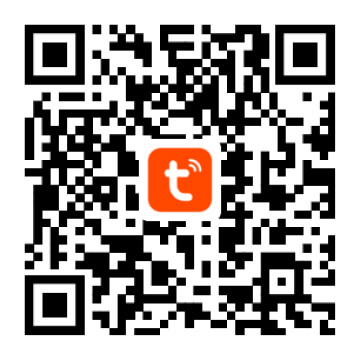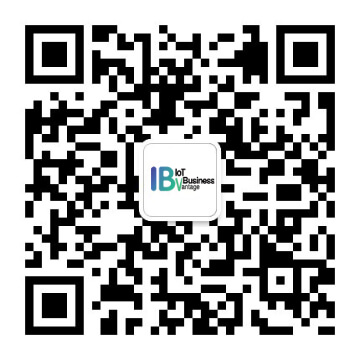场景控制
更新时间:2025-09-22 03:52:42下载pdf
本文介绍场景控制功能。
概述
概念介绍
指在涂鸦智能 App 内创建的预定义操作,即 一键执行场景,这些操作可以通过一种方式下沉至设备端,从而通过设备端触发和控制相应的场景。
该设计使得用户不需要打开手机 App 来触发操作控制,而是直接通过设备端触发和控制相应场景的功能,为用户提供更便捷、智能和简单的方式。
功能描述
将通过涂鸦智能 App 创建的一键执行场景同步至设备,而后在连接的状态下可直接在设备内控制,触发对应场景执行。以下用手表设备来演示具体流程。
-
在 App 端完成场景设置,一键执行。
-
设备与 App 连接,设备触发请求场景数据,App 从云端拉取数据,同步给设备。
-
手表设备获取数据后,显示场景名称和场景。
-
单击手表内某一场景,发送场景控制指令给 App。
-
App 调用相应接口触发云端执行场景,从而实现场景控制。
数据结构
tuya_ble_request_scene_t
请求场景(含场景数据与控制)相关结构体。
/**@brief Request scene type. */
typedef enum {
REQUEST_SCENE_DATA = 1, /**< request scene list data. */
REQUEST_SCENE_CONTROL, /**< request scene control. */
REQUEST_SCENE_CMD_MAX,
} request_scene_cmd;
/**@brief Request scene list data structure. */
typedef struct {
UINT8_T nums; /**< request scene numbers, ranging from [1-SUPPORT_REQUEST_SCENE_MAX_NUMS]. */
UINT16_T name_unicode_length; /**< request scene name length. The encoding format is unicode, and it must be a multiple of 2. */
UINT32_T check_code; /**< scene check code, algorithm-crc32. */
} request_scene_list_data_t;
/**@brief Request scene control structure. */
typedef struct {
UINT8_T scene_id_length; /**< scene id length. */
UINT8_T scene_id[SCENE_ID_MAX_LENGTH]; /**< scene id. Max length equal to SCENE_ID_MAX_LENGTH. */
} request_scene_control_t;
/**@brief Request scene cmd structure. */
typedef struct {
request_scene_cmd scene_cmd; /**< request scene cmd. */
union {
request_scene_list_data_t scene_data; /**< request scene list data info. */
request_scene_control_t scene_control; /**< request scene ctrl info. */
};
} tuya_ble_request_scene_t;
tuya_ble_scene_req_response_t
请求场景响应,回调给应用的数据结构,对应回调事件为 TUYA_BLE_CB_EVT_SCENE_REQ_RESPONSE。
typedef struct {
uint16_t scene_cmd; /**< scene cmd. 1-scene data, 2-scene control */
uint8_t status; /**< response status, 0-success, 1-failed. */
uint32_t err_code; /**< err code, 0-success, others-failed */
} tuya_ble_scene_req_response_t;
tuya_ble_scene_data_received_data_t
请求场景列表数据结果,回调给应用的数据结构,对应回调事件为 TUYA_BLE_CB_EVT_SCENE_DATA_RECEIVED。
typedef struct {
uint8_t status; /**< status, 0-success, 1-failed. */
uint32_t err_code; /**< err code, 0-success, others-failed */
bool need_update; /**< need update, true-need update */
uint32_t check_code; /**< scene data check code, used crc32. */
uint8_t *p_data; /**< scene data. */
uint16_t data_len; /**< scene data length. */
} tuya_ble_scene_data_received_data_t;
tuya_ble_scene_ctrl_received_data_t
请求场景控制结果,回调给应用的数据结构,对应回调事件为 TUYA_BLE_CB_EVT_SCENE_CTRL_RESULT_RECEIVED。
typedef struct {
uint8_t status; /**< status, 0-success, 1-failed. */
uint32_t err_code; /**< err code. */
uint8_t scene_id_len; /**< scene id length. */
uint8_t *p_scene_id; /**< scene id. */
} tuya_ble_scene_ctrl_received_data_t;
接口说明
宏配置依赖
#define TUYA_BLE_FEATURE_IOT_CHANNEL_ENABLE 1
#define TUYA_BLE_FEATURE_SCENE_ENABLE 1
请求场景数据/控制
接口说明
tuya_ble_status_t tuya_ble_feature_scene_request(tuya_ble_request_scene_t *req_data)
参数说明
| 参数 | 说明 |
|---|---|
| req_data | 请求场控数据,支持请求列表数据与控制。详见数据结构 tuya_ble_request_scene_t 定义。 |
回调事件-请求响应
TUYA_BLE_CB_EVT_SCENE_REQ_RESPONSE
| 回调事件 | TUYA_BLE_CB_EVT_SCENE_REQ_RESPONSE |
|---|---|
| 数据结构 | 请求场景 App 返回的响应数据,详见数据结构 tuya_ble_scene_req_response_t 定义 |
| 描述 | 设备调用请求场景 API 接口后,App 回复的请求响应 |
回调事件-场景数据
TUYA_BLE_CB_EVT_SCENE_DATA_RECEIVED
| 回调事件 | TUYA_BLE_CB_EVT_SCENE_DATA_RECEIVED |
|---|---|
| 数据结构 | 请求场景返回的列表数据,详见数据结构 tuya_ble_scene_data_received_data_t 定义 其中 p_data 存放的是返回的所有场景数据,每条场景数据格式 如下表定义: |
| 描述 | App 从云端请求到的一键执行场景数据返回给 SDK,SDK 回调给应用层事件与数据 |
场景数据格式 定义:
| 场景 ID 长度 | 场景 ID | 场景名称长度 | 场景名称 | …… | 场景 ID 长度 | 场景 ID | 场景名称长度 | 场景名称 |
|---|---|---|---|---|---|---|---|---|
| 1 字节 | n 字节 | 2 字节 | m 字节 | …… | 1 字节 | n 字节 | 2 字节 | m 字节 |
回调事件-场景控制
TUYA_BLE_CB_EVT_SCENE_CTRL_RESULT_RECEIVED
| 回调事件 | TUYA_BLE_CB_EVT_SCENE_CTRL_RESULT_RECEIVED |
|---|---|
| 数据结构 | 请求场景控制返回的结果,详见数据结构 tuya_ble_scene_ctrl_received_data_t 定义 |
| 描述 | 场景控制结果,SDK 回调给应用层事件与数据 |
使用方法
通信流程
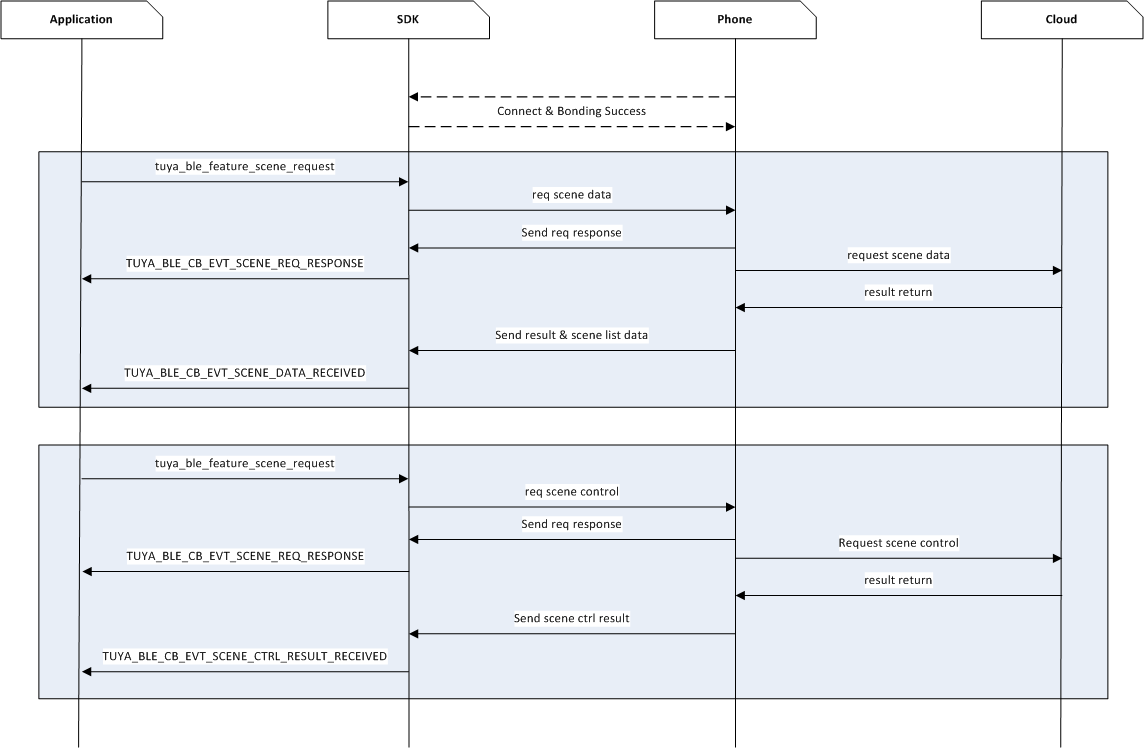
代码开发
在 app_config.h 中启用场景控制组件,使能对应的宏配置。场景控制依赖 IoT 通道通用能力,也需一同使能。
#define TUYA_BLE_FEATURE_IOT_CHANNEL_ENABLE 1
#define TUYA_BLE_FEATURE_SCENE_ENABLE 1
添加请求场景数据/控制代码,以下仅作为示例。
/**
* Example 1: req scene data with the following details:
* Number of scenes: 1
* Scene name Unicode length: 10
* Local scene verification code: 0
*/
tuya_ble_request_scene_t req_scene_data;
req_scene_data.cmd_type = REQUEST_SCENE_DATA;
req_scene_data.scene_data.nums = 1;
req_scene_data.scene_data.name_unicode_length = 10;
req_scene_data.scene_data.check_code = 0;
tuya_ble_feature_scene_request(&req_scene_data);
/**
* Example 2: req scene control with the following details:
* Scene id: "nRAfyPBArgTAPgUq"
*/
tuya_ble_request_scene_t req_scene_data;
static const char test_scene_id[] = "nRAfyPBArgTAPgUq";
req_scene_data.cmd_type = REQUEST_SCENE_CONTROL;
req_scene_data.scene_control.scene_id_length = strlen(test_scene_id);
memcpy(req_scene_data.scene_control.scene_id, test_scene_id, req_scene_data.scene_control.scene_id_length);
tuya_ble_feature_scene_request(&req_scene_data);
在 tuya_ble_protocol_callback.c 中 回调事件处理函数 下添加如下代码,即可实现基本功能。如果测试功能 TUYA_SDK_TEST 是开启的,这些代码已经启用了。代码中涉及到的每个 API 在接口说明中都有涉及。
#include "tuya_ble_scene.h"
STATIC VOID_T tuya_ble_protocol_callback(tuya_ble_cb_evt_param_t* event)
{
switch(event->evt) {
//...
#if (TUYA_BLE_FEATURE_IOT_CHANNEL_ENABLE != 0) && (TUYA_BLE_FEATURE_SCENE_ENABLE != 0)
case TUYA_BLE_CB_EVT_SCENE_REQ_RESPONSE: {
TAL_PR_INFO("received scene request response result code=[%d], err_code=[%d] sub_cmd=[%d]", \
event->scene_req_response_data.status, \
event->scene_req_response_data.err_code, \
event->scene_req_response_data.scene_cmd);
} break;
case TUYA_BLE_CB_EVT_SCENE_DATA_RECEIVED: {
// scene_data
TAL_PR_INFO("received scene data result, status=[%d] err_code=[%d] need_update=[%d] check_code=[0x%X]", \
event->scene_data_received_data.status, \
event->scene_data_received_data.err_code, \
event->scene_data_received_data.need_update, \
event->scene_data_received_data.check_code);
if (event->scene_data_received_data.status == 0 && event->scene_data_received_data.need_update) {
// Todo ... update scene check code.
if (event->scene_data_received_data.data_len != 0) {
UINT8_T *iot_scene_object;
UINT16_T scene_id_len, scene_name_len;
UINT8_T object_len = 0;
for (;;) {
iot_scene_object = (UINT8_T *)(event->scene_data_received_data.p_data + object_len);
scene_id_len = iot_scene_object[0];
scene_name_len = (iot_scene_object[1+scene_id_len] << 8) + iot_scene_object[2+scene_id_len];
TAL_PR_HEXDUMP_INFO("scene id :", &iot_scene_object[1], scene_id_len);
TAL_PR_HEXDUMP_INFO("scene name unicode :", &iot_scene_object[3+scene_id_len], scene_name_len);
object_len += (3 + scene_id_len + scene_name_len);
if (object_len >= event->scene_data_received_data.data_len)
break;
}
}
}
} break;
case TUYA_BLE_CB_EVT_SCENE_CTRL_RESULT_RECEIVED: {
TAL_PR_INFO("received scene ctrl result, status=[%d] err_code=[%d]", \
event->scene_ctrl_received_data.status, \
event->scene_ctrl_received_data.err_code);
TAL_PR_HEXDUMP_INFO("scene ctrl id:", event->scene_ctrl_received_data.p_scene_id, \
event->scene_ctrl_received_data.scene_id_len);
} break;
#endif // (TUYA_BLE_FEATURE_IOT_CHANNEL_ENABLE != 0) && (TUYA_BLE_FEATURE_SCENE_ENABLE != 0)
//...
}
}
功能测试
前置条件
- 您已经下载了涂鸦智能 App。
- 确认您的设备已完成配网。
- 在 App 上已创建好一键执行场景,操作详见 创建一键执行。
创建场景-一键执行
-
打开涂鸦智能 App。
-
单击底部的 场景,选择 创建智能场景 > 一键执行。
-
选择执行条件,并保存。
-
查看创建一键执行的结果。
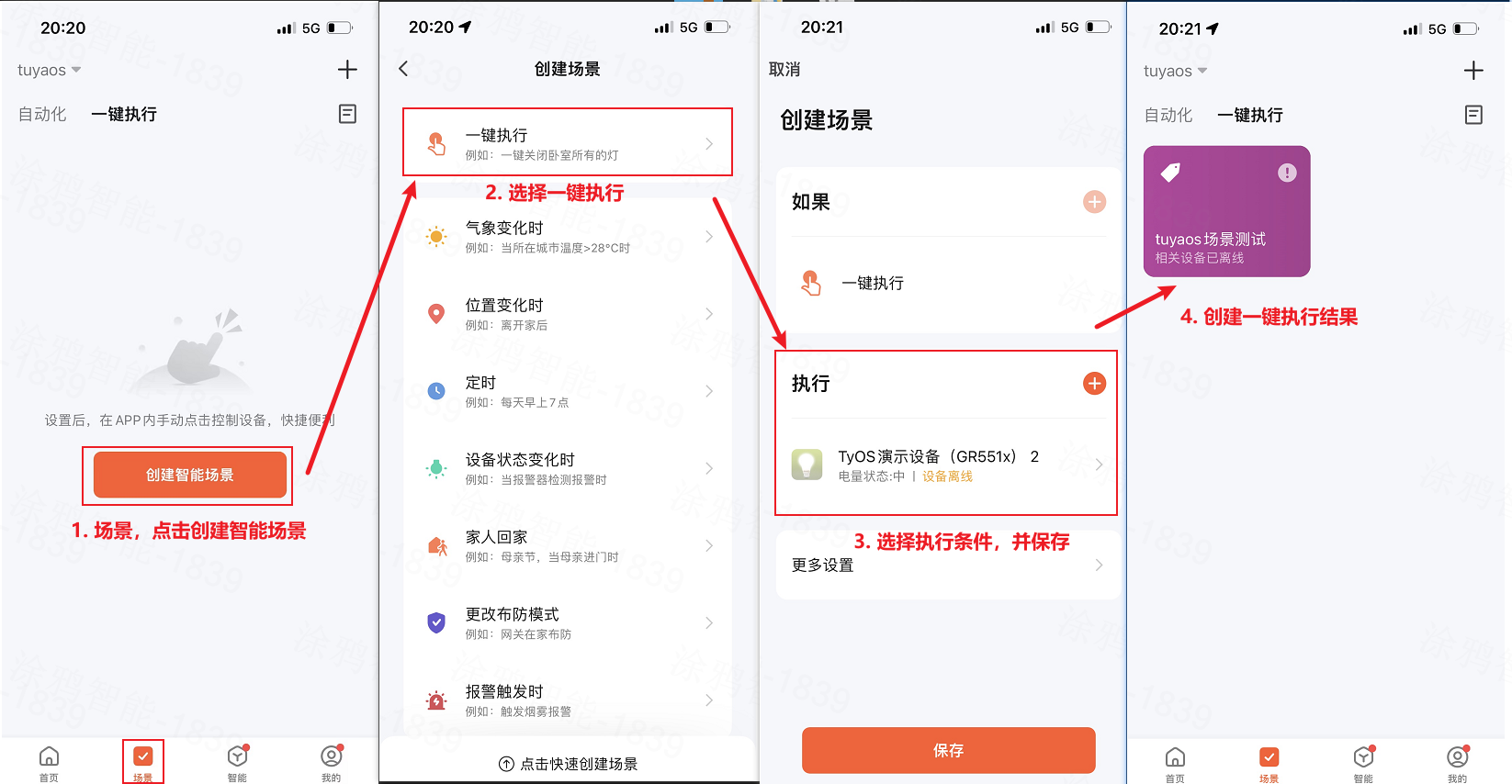
操作步骤
通过上位机(模拟实际产品)和手机 App 进行数据交互,如下图所示:
请求场景数据
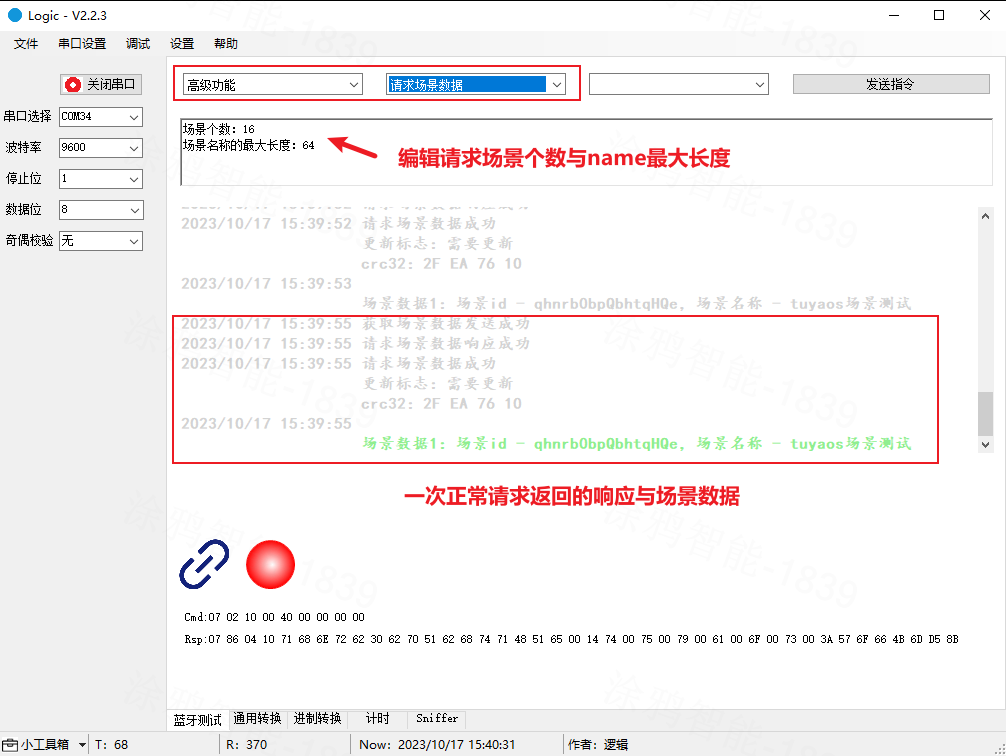
请求场景控制
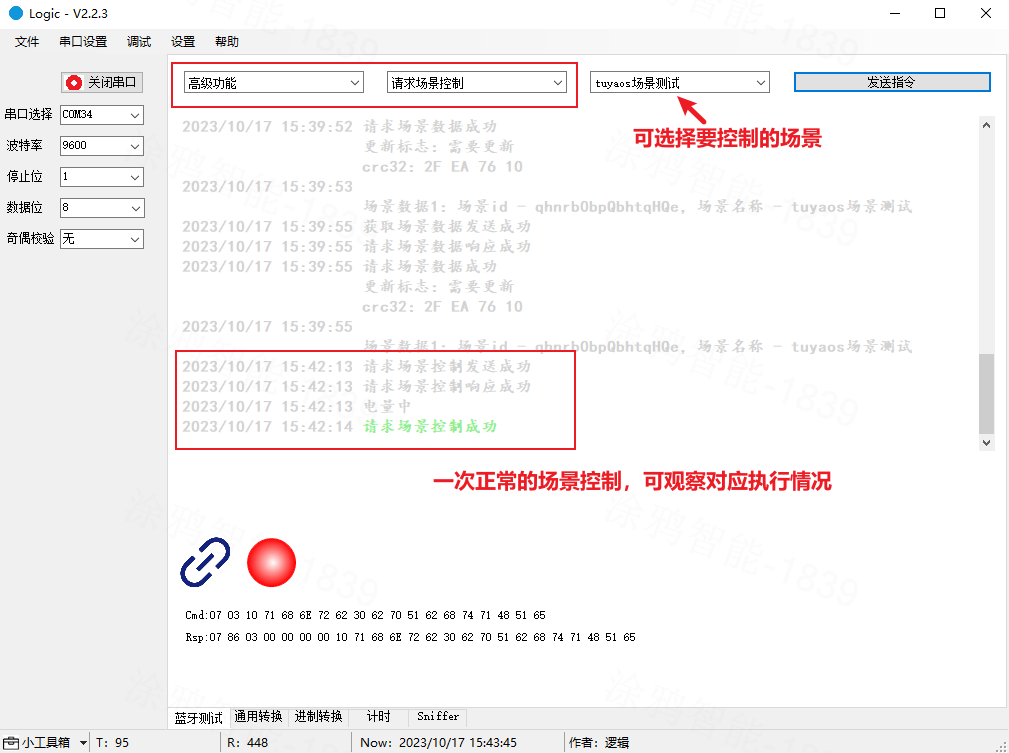
上位机使用的相关问题,请访问 Logic 上位机使用指南。
支持与帮助
在开发过程遇到问题,您可以登录 TuyaOS 开发者论坛 TuyaOS-蓝牙设备开发 版块进行沟通咨询。
该内容对您有帮助吗?
是意见反馈该内容对您有帮助吗?
是意见反馈

